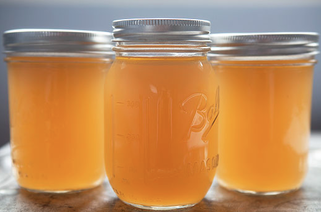
Bone Broth (otherwise known as "stock") is a nourishing food for our entire body. It is full of nutrients and can aid with digestion, fight infection, reduce inflammation, and promote strong bones...need I go on? What I love about bone broth is how easy it is to make in large quantities. I make some every few months and freeze it for use later. You can drink as a tea, use it as the base for cooking whole grains or making soup. There is no one single recipe. I adapted these ideas from Natasha Campbell-Mcbride's book, The GAPS diet.
- To make good meat stock you need joints, bones, a piece of meat on the bone, a whole chicken, giblets from chicken, goose or duck, whole pigeons, pheasants or other inexpensive meats. Preferably grass fed/free range/organic.
- The bones and joints are the most important ingredients in the broth. They provide marrow and cartilage tissue, these are the healing substances. Muscle meats are for flavor.
- Ask the butcher to cut in half the large tubular bones, so you can get the bone marrow out of them after cooking. I have found many co-ops carry soup bones or "dog bones" from grass fed cows cut perfectly for making bone broth.
- Add vegetable scraps such as red onion skins, celery, stems from kale etc. Start freezing vegetable scraps so that you have plenty when you want to make stock.
- Put the bones, joints and meats into a large pan and fill it up with water, add natural unprocessed salt to your taste at the beginning of cooking and about a teaspoon of black peppercorns, roughly crushed. Bring to boil, cover and simmer on a low heat for 2.5 - 3 hours.
- You can make fish stock the same way using a whole fish or fish fins, bones and heads.
- After cooking take the bones and meats out and sieve the stock to remove small bones and pepper corns.
- If the bone marrow hasn't been absorbed in to the broth while cooking. Physically remove the bone marrow from the bones and add it to the broth. This is an important, extremely nutrient rich substance.
- For medicinal purposes, especially when healing your GI tract, drink this broth several times per day .
- Do not use microwaves for warming up the stock, use a conventional stove top.
- Don't skim the top of the stock when you are finished.It is very important to consume all the fat in the stock and off the bones as these fats are essential for the healing process.
- Other things to add to your broth:
- Apple cider vinegar at the end while it is cooling and the bones are still in the pot. This helps pull minerals such as calcium out of the bones and in to the broth.
- Bay leaf
- Dried asian mushrooms
- Sprigs of herbs
- Seaweed
- Apple cider vinegar at the end while it is cooling and the bones are still in the pot. This helps pull minerals such as calcium out of the bones and in to the broth.
- To preserve the nutrients I recommend consuming within 2-3 days of cooking and freezing what you won't consume in that time frame. Glass mason jars work well to freeze the broth, just make sure the broth is cool. Don't put a lid on until they are frozen to prevent breaking from liquid expansion.

 RSS Feed
RSS Feed